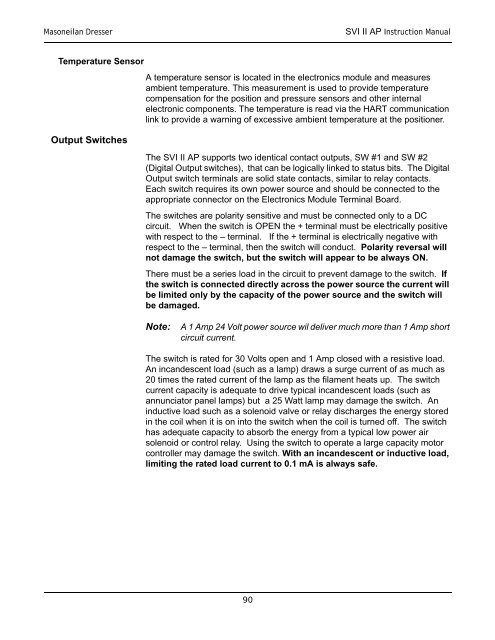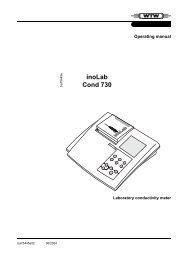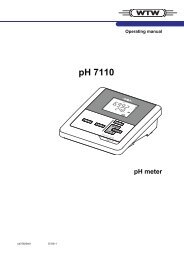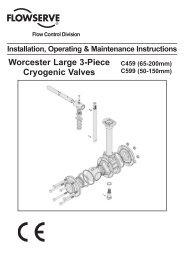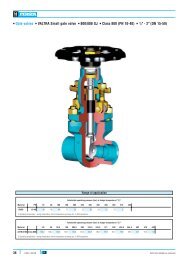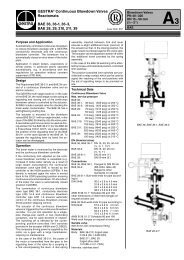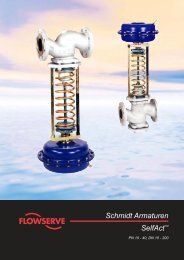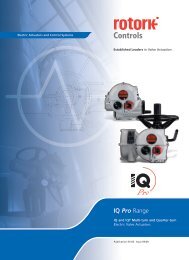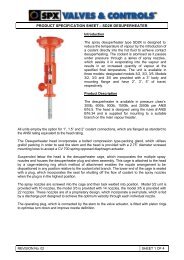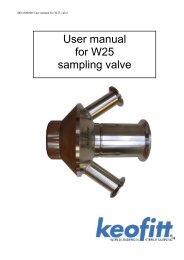SVI-II Instruc Man.book - Fagerberg
SVI-II Instruc Man.book - Fagerberg
SVI-II Instruc Man.book - Fagerberg
You also want an ePaper? Increase the reach of your titles
YUMPU automatically turns print PDFs into web optimized ePapers that Google loves.
Masoneilan Dresser<br />
<strong>SVI</strong> <strong>II</strong> AP <strong>Instruc</strong>tion <strong>Man</strong>ual<br />
Temperature Sensor<br />
Output Switches<br />
A temperature sensor is located in the electronics module and measures<br />
ambient temperature. This measurement is used to provide temperature<br />
compensation for the position and pressure sensors and other internal<br />
electronic components. The temperature is read via the HART communication<br />
link to provide a warning of excessive ambient temperature at the positioner.<br />
The <strong>SVI</strong> <strong>II</strong> AP supports two identical contact outputs, SW #1 and SW #2<br />
(Digital Output switches), that can be logically linked to status bits. The Digital<br />
Output switch terminals are solid state contacts, similar to relay contacts.<br />
Each switch requires its own power source and should be connected to the<br />
appropriate connector on the Electronics Module Terminal Board.<br />
The switches are polarity sensitive and must be connected only to a DC<br />
circuit. When the switch is OPEN the + terminal must be electrically positive<br />
with respect to the – terminal. If the + terminal is electrically negative with<br />
respect to the – terminal, then the switch will conduct. Polarity reversal will<br />
not damage the switch, but the switch will appear to be always ON.<br />
There must be a series load in the circuit to prevent damage to the switch. If<br />
the switch is connected directly across the power source the current will<br />
be limited only by the capacity of the power source and the switch will<br />
be damaged.<br />
Note:<br />
A 1 Amp 24 Volt power source wil deliver much more than 1 Amp short<br />
circuit current.<br />
The switch is rated for 30 Volts open and 1 Amp closed with a resistive load.<br />
An incandescent load (such as a lamp) draws a surge current of as much as<br />
20 times the rated current of the lamp as the filament heats up. The switch<br />
current capacity is adequate to drive typical incandescent loads (such as<br />
annunciator panel lamps) but a 25 Watt lamp may damage the switch. An<br />
inductive load such as a solenoid valve or relay discharges the energy stored<br />
in the coil when it is on into the switch when the coil is turned off. The switch<br />
has adequate capacity to absorb the energy from a typical low power air<br />
solenoid or control relay. Using the switch to operate a large capacity motor<br />
controller may damage the switch. With an incandescent or inductive load,<br />
limiting the rated load current to 0.1 mA is always safe.<br />
90


